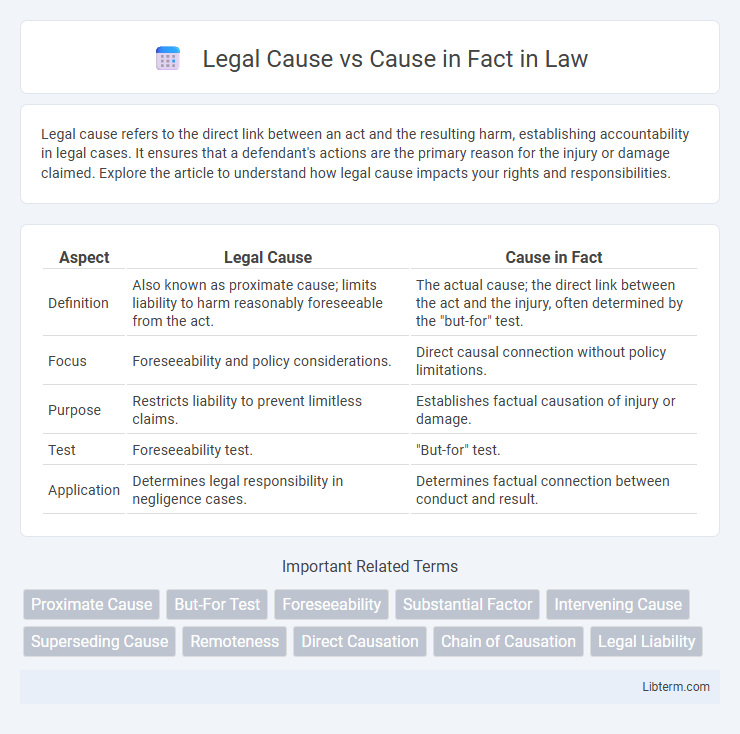Legal cause refers to the direct link between an act and the resulting harm, establishing accountability in legal cases. It ensures that a defendant's actions are the primary reason for the injury or damage claimed. Explore the article to understand how legal cause impacts your rights and responsibilities.
Table of Comparison
| Aspect | Legal Cause | Cause in Fact |
|---|---|---|
| Definition | Also known as proximate cause; limits liability to harm reasonably foreseeable from the act. | The actual cause; the direct link between the act and the injury, often determined by the "but-for" test. |
| Focus | Foreseeability and policy considerations. | Direct causal connection without policy limitations. |
| Purpose | Restricts liability to prevent limitless claims. | Establishes factual causation of injury or damage. |
| Test | Foreseeability test. | "But-for" test. |
| Application | Determines legal responsibility in negligence cases. | Determines factual connection between conduct and result. |
Introduction to Legal Cause and Cause in Fact
Legal cause refers to the proximate cause in a negligence claim, establishing a direct connection between the defendant's actions and the plaintiff's injury within the scope of foreseeable harm. Cause in fact, also known as actual cause, is determined by the "but-for" test, which assesses whether the injury would have occurred absent the defendant's conduct. Distinguishing legal cause from cause in fact is critical for proving liability in tort law, ensuring that only proximate and actual causes are held accountable.
Defining Legal Cause (Proximate Cause)
Legal cause, also known as proximate cause, refers to the primary cause recognized by law as sufficiently related to the harm incurred, establishing liability in negligence cases. It limits liability to consequences that bear a reasonable connection to the defendant's actions, preventing limitless responsibility for unforeseen results. Courts apply legal cause to ensure that only foreseeable and direct damages attributable to the defendant's conduct result in legal accountability.
Understanding Cause in Fact (Actual Cause)
Cause in fact, also known as actual cause, refers to the direct, factual cause of an event or injury. It is established by the "but-for" test, which asks whether the harm would have occurred absent the defendant's actions. Understanding cause in fact is essential in legal contexts to determine liability based on whether the defendant's conduct was the actual cause of the plaintiff's damages.
Legal Cause vs Cause in Fact: Key Differences
Legal cause refers to the proximate cause that establishes a direct link between the defendant's actions and the plaintiff's harm, determining liability under the law. Cause in fact, or actual cause, requires that the harm would not have occurred "but for" the defendant's conduct, focusing on factual causation. The key difference lies in legal cause addressing policy-based limitations on liability, while cause in fact strictly examines factual connections.
The "But For" Test Explained
The "But For" test determines cause in fact by asking whether the harm would have occurred but for the defendant's conduct. Legal cause, or proximate cause, limits liability to consequences reasonably foreseeable from the defendant's actions. This distinction ensures that only direct, factual causes are linked to liability, preventing expansive accountability for distant outcomes.
Foreseeability in Legal Cause
The concept of Legal Cause hinges on foreseeability, which limits liability to consequences that a reasonable person could predict from their actions. Cause in Fact, often established through the "but-for" test, determines whether the harm would not have occurred absent the defendant's conduct. Courts emphasize foreseeability in Legal Cause to ensure that defendants are only held liable for damages within a foreseeable scope, preventing endless chains of liability.
Application in Negligence Cases
Legal cause, also known as proximate cause, determines whether the harm caused was a foreseeable result of the defendant's actions in negligence cases. Cause in fact requires proving that the defendant's conduct was the actual cause of the injury, usually established using the "but for" test. Courts apply both concepts to limit liability, ensuring defendants are only held responsible for damages directly linked to their negligence.
Landmark Cases: Legal Cause and Cause in Fact
Landmark cases such as Palsgraf v. Long Island Railroad Co. illustrate the distinction between cause in fact and legal cause, where cause in fact established the direct connection between defendant's action and plaintiff's injury, but legal cause examined foreseeability and proximate cause limits. In Tarasoff v. Regents of the University of California, the court emphasized legal cause by extending duty to prevent harm based on foreseeability, shaping negligence liability boundaries. These cases collectively define how courts assess liability by balancing factual causation and policy-driven legal cause criteria.
Common Misunderstandings and Challenges
Legal cause, also known as proximate cause, is often confused with cause in fact, which directly links an act to an injury. Common misunderstandings arise when individuals assume that cause in fact alone establishes liability, neglecting the necessity of legal cause to limit responsibility within reasonable bounds. Challenges include determining foreseeability and policy considerations, which play critical roles in distinguishing legal cause from mere factual causation.
Conclusion: The Importance of Distinguishing Causes
Distinguishing legal cause from cause in fact is essential for accurately assigning liability in tort law. Legal cause limits responsibility to consequences that are reasonably foreseeable, while cause in fact establishes a direct link between conduct and outcome. Understanding this distinction ensures just and precise adjudication of damages.
Legal Cause Infographic

 libterm.com
libterm.com